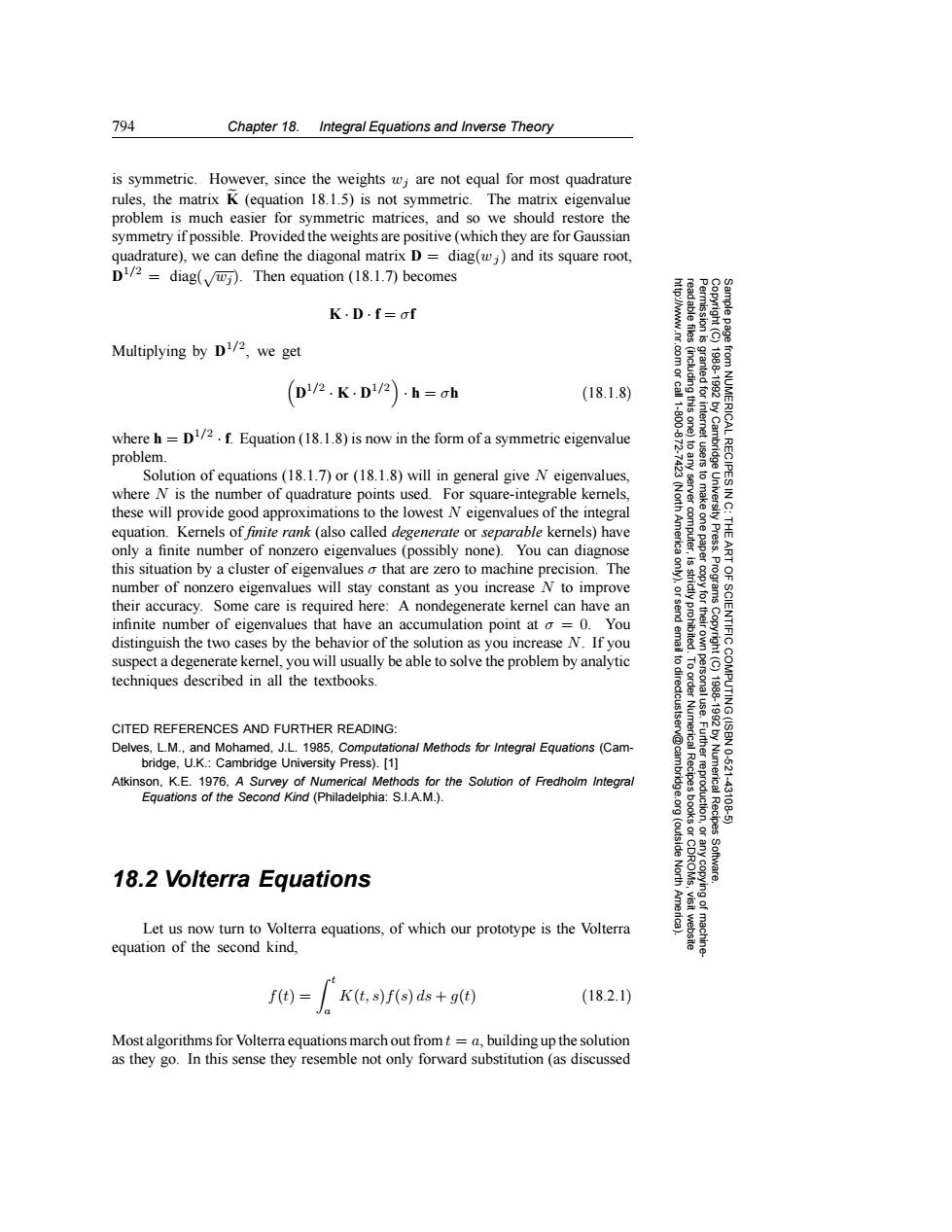正在加载图片...

794 Chapter 18.Integral Equations and Inverse Theory is symmetric.However,since the weights w;are not equal for most quadrature rules,the matrix K(equation 18.1.5)is not symmetric.The matrix eigenvalue problem is much easier for symmetric matrices,and so we should restore the symmetry if possible.Provided the weights are positive(which they are for Gaussian quadrature),we can define the diagonal matrix D diag(wi)and its square root, D/2=diag().Then equation(18.1.7)becomes K.D.f=of 三 Multiplying by D/2,we get (D1/2.K.D1/2).h=ch (18.1.8) nted for where h=D1/2.f.Equation(18.1.8)is now in the form ofa symmetric eigenvalue problem. Solution of equations (18.1.7)or (18.1.8)will in general give N eigenvalues, where N is the number of quadrature points used.For square-integrable kernels, 2 these will provide good approximations to the lowest N eigenvalues of the integral equation.Kernels of finite rank (also called degenerate or separable kernels)have only a finite number of nonzero eigenvalues(possibly none).You can diagnose this situation by a cluster of eigenvalues o that are zero to machine precision.The number of nonzero eigenvalues will stay constant as you increase N to improve 9 their accuracy.Some care is required here:A nondegenerate kernel can have an infinite number of eigenvalues that have an accumulation point at o =0.You SCIENTIFIC( distinguish the two cases by the behavior of the solution as you increase N.If you suspect a degenerate kernel,you will usually be able to solve the problem by analytic 6 techniques described in all the textbooks CITED REFERENCES AND FURTHER READING: Delves,L.M.,and Mohamed,J.L.1985,Computational Methods for Integral Equations (Cam- bridge,U.K.:Cambridge University Press).[1] Numerical Recipes 10.621 Atkinson,K.E.1976,A Survey of Numerical Methods for the Solution of Fredholm Integral Equations of the Second Kind(Philadelphia:S.I.A.M.). 43106 (outside 18.2 Volterra Equations Software. Let us now turn to Volterra equations,of which our prototype is the Volterra equation of the second kind, f(t)= K(t,s)f(s)ds+g(t) (18.2.1) Q Most algorithms for Volterra equations march out fromt =a,building up the solution as they go.In this sense they resemble not only forward substitution (as discussed794 Chapter 18. Integral Equations and Inverse Theory Permission is granted for internet users to make one paper copy for their own personal use. Further reproduction, or any copyin Copyright (C) 1988-1992 by Cambridge University Press. Programs Copyright (C) 1988-1992 by Numerical Recipes Software. Sample page from NUMERICAL RECIPES IN C: THE ART OF SCIENTIFIC COMPUTING (ISBN 0-521-43108-5) g of machinereadable files (including this one) to any server computer, is strictly prohibited. To order Numerical Recipes books or CDROMs, visit website http://www.nr.com or call 1-800-872-7423 (North America only), or send email to directcustserv@cambridge.org (outside North America). is symmetric. However, since the weights wj are not equal for most quadrature rules, the matrix K (equation 18.1.5) is not symmetric. The matrix eigenvalue problem is much easier for symmetric matrices, and so we should restore the symmetry if possible. Provided the weights are positive (which they are for Gaussian quadrature), we can define the diagonal matrix D = diag(wj ) and its square root, D1/2 = diag( √wj ). Then equation (18.1.7) becomes K · D · f = σf Multiplying by D1/2, we get D1/2 · K · D1/2 · h = σh (18.1.8) where h = D1/2 · f. Equation (18.1.8) is now in the form of a symmetric eigenvalue problem. Solution of equations (18.1.7) or (18.1.8) will in general give N eigenvalues, where N is the number of quadrature points used. For square-integrable kernels, these will provide good approximations to the lowest N eigenvalues of the integral equation. Kernels of finite rank (also called degenerate or separable kernels) have only a finite number of nonzero eigenvalues (possibly none). You can diagnose this situation by a cluster of eigenvalues σ that are zero to machine precision. The number of nonzero eigenvalues will stay constant as you increase N to improve their accuracy. Some care is required here: A nondegenerate kernel can have an infinite number of eigenvalues that have an accumulation point at σ = 0. You distinguish the two cases by the behavior of the solution as you increase N. If you suspect a degenerate kernel, you will usually be able to solve the problem by analytic techniques described in all the textbooks. CITED REFERENCES AND FURTHER READING: Delves, L.M., and Mohamed, J.L. 1985, Computational Methods for Integral Equations (Cambridge, U.K.: Cambridge University Press). [1] Atkinson, K.E. 1976, A Survey of Numerical Methods for the Solution of Fredholm Integral Equations of the Second Kind (Philadelphia: S.I.A.M.). 18.2 Volterra Equations Let us now turn to Volterra equations, of which our prototype is the Volterra equation of the second kind, f(t) = t a K(t, s)f(s) ds + g(t) (18.2.1) Most algorithms for Volterra equations march out from t = a, building up the solution as they go. In this sense they resemble not only forward substitution (as discussed��